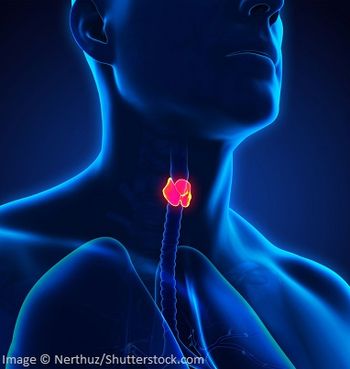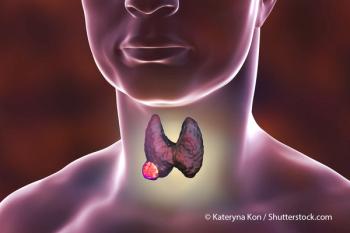
I-131 for Thyroid Cancer Metastases
In this interview we discuss which distant metastases in thyroid cancer are appropriate targets for I-131 treatment, appropriate dosing, and more.
As part of Cancer Network’s coverage of the 86th Annual Meeting of the American Thyroid Association (ATA), held September 21-25 in Denver, Colorado, we spoke with Douglas Van Nostrand, MD. Dr. Van Nostrand is the director of nuclear medicine research at MedStar Health Research Institute in Washington, DC. He has published more than 200 papers in the scientific literature, and is senior editor of the book entitled Thyroid Cancer: A Guide for Patients, and co-editor of the medical textbook entitled Thyroid Cancer: A Guide to Comprehensive Management.
Cancer Network: How do you determine whether distant metastases are appropriate targets for I-131 treatment? Can you describe the strengths and limitations of whole-body radioiodine imaging as a staging tool before radioiodine treatment?
Dr. Van Nostrand: I think that there are several ways, but at this point there are a lot of controversies, as well. The most appropriate approach is a radioiodine scan to see if metastatic tumors are taking up I-131 and are thus I-131 functioning cancer. The problem with the scan is that at lower doses, scans don’t pick up all functioning metastases. The dilemma becomes whether or not the patient should be considered to be radioiodine-refractory. Some proponents say when the scan is negative, the patient is refractory. But nobody really knows at that point that they are refractory. There is literature suggesting that if you treat with radioiodine therapy 20% to 64% will have I-131 uptake on a post-therapy scan. Hence, they are radioactive iodine functioning. Now, that doesn’t mean they would get a therapeutic benefit-but it implies they would have that possibility.
There’s exciting work coming along by Alan Ho, MD, and James Fagin, MD, at Memorial Sloan Kettering Cancer Center, that MEK inhibitors might re-establish or re-allow the radioiodine symporter to take up I-131 again-and if the cancer is taking up I-131, then it might be responsive to treatment.
Cancer Network: What about the organs bearing distant metastatic tumors-is I-131 typically more effective for some sites of metastasis than other sites?
Dr. Van Nostrand: What is more important is the function of the metastasis, as opposed to the site. However, an important exception is brain metastasis, which is in a closed vault. But for bone, lung-virtually any organ can be involved-what’s important is not the site but the degree of I-131 uptake.
Another important, but less frequently considered parameter is how long the radioiodine remains in the distant metastasis. The longer it remains there, the higher the radiation absorbed–dose delivered, and the better potential outcome.
Cancer Network: How do you determine appropriate I-131 doses?
Dr. Van Nostrand: The selection for the dose to treat distant metastases is again controversial. There are three methods: empiric, and dosimetric methods. One dosimetric approach is to calculate the maximum dose to the bone marrow, and the second is to calculate the radiation exposure dose to the distant metastasis.
On the research side, we are doing lesional dosimetry to determine radiation dose to lesion. But for our clinical patients, we perform full or classical dosimetry, or if they are not available for 5 days to do full dosimetry, we can do a simplified or abbreviated measurement.
Cancer Network: What can you tell us about metformin or investigational agents as radioprotective medications for patients undergoing I-131 treatment?
Dr. Van Nostrand: Two of our research fellows have shown that there may be a protective effect of metformin on bone marrow for radiation exposure. Joanna Klubo-Gwiezdzinska, MD, PhD, and Athanasios Bikas, MD, are both evaluating metformin in differentiated thyroid cancer, and their initial data demonstrate promise of protective effects of metformin on hematopoietic parameters after I-131. Dr. Bikas recently coauthored a paper about a potential benefit for metformin in reducing the amount of hematopoietic suppression.[1] However, further work is needed to validate the protective effects of metformin.
Cancer Network: If validated, that suggests that metformin could allow delivery of higher radiation doses to metastatic tumors?
Dr. Van Nostrand: Yes, and there are many other factors being studied to increase the delivery of more radiation dose to the metastases. If there are also interventions that can reduce side effects, that would also increase therapeutic doses, with hopefully better outcomes.
There are several possibilities. One is to increase delivered rads to the metastasis by giving higher doses of I-131 while implementing additional interventions to minimize side effects. Two, for a given dose, you want greater uptake by the distant metastasis. Selumetinib is an investigational drug under study at Memorial Sloan Kettering that potentially increases I-131 uptake. For the same dose administered, one could then help the cancer to take more of the administered I-131.
An often-forgotten part of radiation delivery is keeping the I-131 in the cancer! If it comes out too fast, it doesn’t irradiate the tumor for very long. So, the third area of research is to try to affect “residence time.” Lithium is being evaluated for this purpose at the National Institutes of Health.
The other approach is giving what is called “cold” or non-radioactive iodine. You take a large load of non-radioactive iodine orally, which blocks the release of the radioactive iodine that is already in the thyroid. So the radioactivity of the I-131 in the thyroid stays there longer, and more radiation is delivered per millicurie taken up.
So while metformin may be potentially useful to reduce side effects, selumetinib is trying to enhance the I-131 uptake, and lithium and cold iodine are trying to keep the I-131 in the cancer cell longer.
Cancer Therapy: What can you tell us about managing metastatic differentiated thyroid cancer with I-131?
Dr. Van Nostrand: It’s natural for individuals to seek a standard use of I-131 but differentiated thyroid cancer distant metastasis has a variable spectrum of behavior. I really believe that each patient should be managed individually and that there is no single, simple algorithm for these patients. I’m a big proponent of individualization of managing distant metastases. And in many cases, it’s not I-131. In selected patients, surgery, radiofrequency ablation, cryotherapy, or external-beam radiotherapy may be used initially, followed by radioiodine.
Cancer Therapy: What about genomics and biomarkers of I-131 efficacy?
Dr. Van Nostrand: I think that’s coming. I think that’s coming in terms of helping to determine which tumors are more likely to develop distant metastasis, and which will respond to I-131.
Reference
1. Bikas A, Van Nostrand D, Jensen K, et al. Metformin attenuates 131I-induced decrease in peripheral blood cells in patients with differentiated thyroid cancer. Thyroid. 2016;26:280–286.
Newsletter
Stay up to date on recent advances in the multidisciplinary approach to cancer.















































































